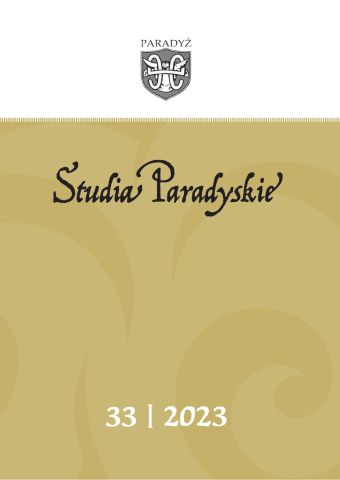
ISSN: 0860-8539
eISSN: 2956-4204
OAI
DOI: 10.18276/sp.2023.33-13




Issue archive /
33/2023
Grzech Pierworodny według nauki Kościoła prawosławnego
(Original sin according to the teaching of the Orthodox Church)
| Authors: |
Paweł
Stefanowski

Uniwersytet Szczeciński |
| Keywords: | Anthropology man fall sin original sin salvation |
| Data publikacji całości: | 2023-12 |
| Page range: | 17 (207-223) |
| Downloads ?: | 203 |
Abstract
The subject of the article is the original sin, the sin of the first people – Adam and Eve – in the Orthodox tradition called the fall, corruption or most often the sin of the first parents. This fateful event, which took place at the dawn of human history, brought about repercussions that humanity still feels today. Over the centuries, the concept of the fall of Adam and Eve has given rise to many different concepts. The article deals with the concept of original sin according to the teaching of the Orthodox Church and presents the views of the Fathers of the Church and church writers on the act of creation of man, the state of man before the fall and the characteristics of the created human nature. Man created in the image and likeness of God failed to achieve the intended goal, which was divinization, which ultimately led to the fall. The fall brought about the mortality of man, which in turn gave all mankind the certain consequences of original sin itself. This has given rise to polemics over the centuries. Unlike the views of Western theologians such as St. Augustine, the creator of the doctrine of the heredity of original sin, Christian east according to Church Fathers as well as contemporary theologians has always held the position that the sin of the first parents is a personal sin of Adam and Eve, and their descendants only inherit its effects. The purpose of this paper is to show a different concept on the fall of the first people and to present an alternative point of view on the state of man after the fall, as well as to explain the discrepancies, among others, regarding the dogma of the Immaculate Conception of the Blessed Virgin Mary, which is not recognized by the Orthodox Church
Download file
Article file
Bibliography
| 1. | Anchimiuk Jan (ABP. Jeremiasz), Aniołów sądzić będziemy, Warszawa 1981. |
| 2. | Augustyn św., O kazaniu Pana na górze. Do Symplicjusza o różnych problemach. Problemy ewangeliczne, tłum. S. Ryznar, J. Sulowski, Warszawa 1989. |
| 3. | Clement O., Źródła Początki mistyki chrześcijańskiej, tłum. H. Paprocki, Warszawa 2013. |
| 4. | Evdokimov P., Prawosławie, tłum. J. Klinger, Warszawa 1986. |
| 5. | Grzegorz z Nazjanzu św., Mowy wybrane, Mowa 45, II Mowa na Święto Paschy PG 36, 632 C, Warszawa 1967. |
| 6. | Grzegorz z Nyssy św., De hominis opificio XVI; PG 44, 184AC, [w:] H. de Lubac, Katolicyzm, tłum. M. Stokowska, Kraków 1988. |
| 7. | Grzegorz z Nyssy, O stworzeniu człowieka, Kraków 2009. |
| 8. | Jan Damasceński św., Wykład Wiary Prawdziwej, Warszawa 1969. |
| 9. | Katechizm Kościoła katolickiego, Pallottinum 1994. |
| 10. | Kelly J.N.D., Początki doktryny chrześcijańskiej, tłum. J. Mrukówna, Warszawa 1988. |
| 11. | Łosski W., Teologia mistyczna Kościoła wschodniego, Wydawnictwo Uniwersytetu Jagiellońskiego, Kraków 2007. |
| 12. | Meyendorff J., Teologia bizantyjska. Historia i doktryna, tłum. J. Prokopiuk, Warszawa 1984. |
| 13. | Naumowicz J., Wcielenie Boga i zbawienie człowieka, „Warszawskie Studia Teologiczne” 13 (2000), s. 17–30. |
| 14. | Sieniatycki M., Zarys dogmatyki katolickiej „Grzech pierworodny jest grzechem natury”, Kraków 1929. |
| 15. | Towarzystwo Naukowe KUL, Encyklopedia Katolicka, tom VI, Lublin 1993. |
| 16. | Ware K., Kościół prawosławny, Białystok 2011 |